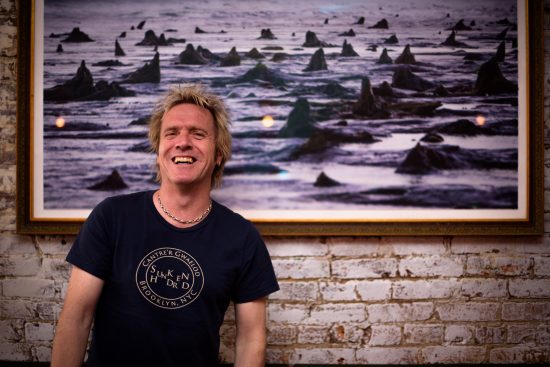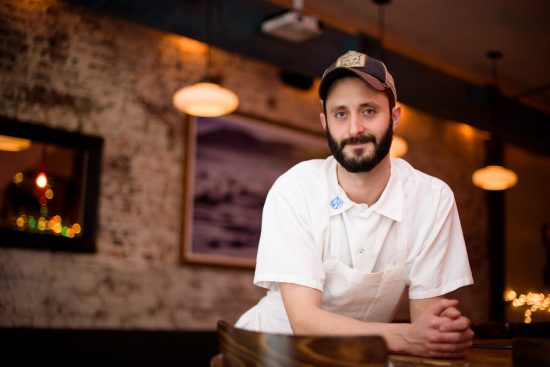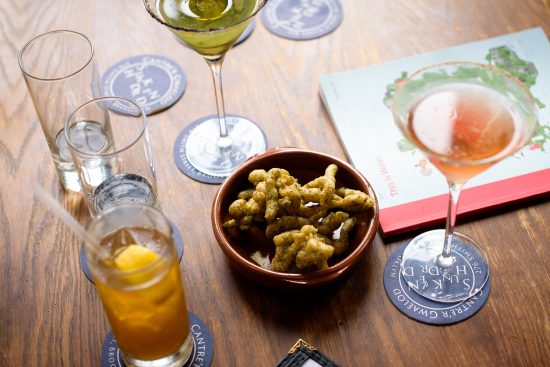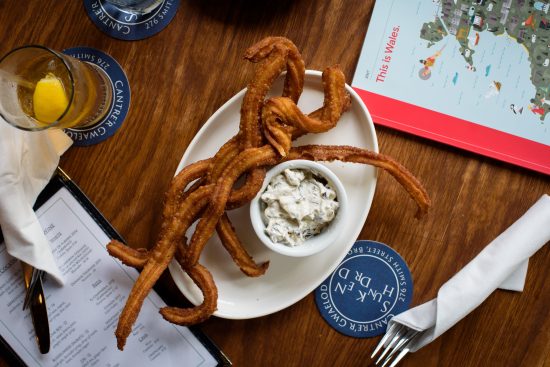In 2011, Illtyd Barrett (Management ‘12) was on a mission: to put Welsh cuisine on the map. A builder, an artist and an experienced cook, he had all of the ingredients for a restaurant — except the business savvy, which is why he enrolled at ICE. There, he met Tom Coughlan (Culinary/Management ‘12), a young, aspiring chef who had recently switched courses from finance to culinary arts.
When Illtyd was ready to open a restaurant, Tom’s “job application,” famously captured by the New Yorker (presenting two quarts of blood and pig skin from a freshly slaughtered swine), instantly landed him the head chef position. Today, the two ICE grads are serving up Welsh cuisine at Sunken Hundred in Brooklyn, which has quickly become the center for Welsh culture outside of Wales.
The menu features Welsh specialties like lamb pasties and Gwaun Valley trout, and seaweed foraged on the coasts of Wales pops up in unexpected places, from cocktails to desserts. Like a Welsh version of Cheers, the space has the cozy feel of a neighborhood pub — only one that serves refined and delicious food.
On a Friday before the rush of dinner service, we caught up with Illtyd and Tom at Sunken Hundred. They invited us to sample their seaweed-laden fare (warning: the bar snack of laver seaweed fried into salty, light puffs is highly addictive), and dished on Welsh cuisine, their path to opening a restaurant and the importance of choosing a good business partner. Said Tom, “If you are ying, you need to find your yang.”
ICE: How did you guys meet?
Tom: We were in class together at ICE. I taught Illtyd how to copy and paste. That was our first interaction.
Like with a computer?
Illtyd: Yes, these bloody things get on my bloody nerves. I’m all about chisels and tools and things like that. I remember we were in the Excel class and I had no idea what spreadsheets were. Copy and paste what? What the hell you going on about?
Tom: Yeah, we sat next to each other in our management class and just hit it off.
And that’s how it all began?
Illtyd: I was always really impressed with Tom’s dedication, and I still am to this day. I mean, we had a lot of things in common in our approach to food and why we enjoy it, I suppose. When my brother and I were planning the restaurant, I spoke to Tom and I asked him if he had ever slaughtered an animal. He decided on a fully-grown male pig. I said good luck — because it’s a horrible, really awful thing to do. I know because I slaughtered cows and calves on my family’s dairy farm.

It’s messy work I imagine.
Illtyd: Yeah, it is. But to prepare an animal like that you have to respect the animal. To do that to a fish is one thing, but a big mammal is totally different. And I asked him, “Can you give me a pound of skin and two quarts of blood?” That was on a Friday. I wanted it to make a Malaysian pig blood curry. And he ended up bringing it to me in on Monday and I felt so guilty, so horrible!
Tom: I chose to do it. The opportunity arose and I was excited to do it, too.
Illtyd: I was really impressed.
And so he passed the test?
Illtyd: Well it wasn’t a test, but I was really impressed. Tom has got a very mature head on his shoulders.
So why, of all the culinary schools, did you choose to come to ICE?
Tom: I went to four years of business school at Fordham. I had contemplated culinary school beforehand and halfway through Fordham, when I was skipping class to go to the butcher shop and cook, I realized I definitely needed to do this professionally. I wanted a quick program, so I graduated and started at ICE two months later.

Did you have visions of opening a restaurant?
Tom: Oh yeah, totally. I wanted an entrepreneurial focus but food was also very important to me so, that is why I did the dual diploma program [Culinary Arts and Restaurant & Culinary Management]. I knew I didn’t just want to be the best line cook in the city. I wanted to understand the full picture of how a restaurant operates and how it runs, and be able to know every part of it.
Illtyd: Yeah, with me I suppose I needed to get a grasp on management. I knew that as much as I loved cooking, I am just too old to be in the kitchen now. For years, the family wanted me to get in the kitchen and I had done some chef’ing for a while and I loved that but I’m really more into construction. I build places and I build bars and as much as I loved cooking, I realized I don’t want to be in the kitchen. I have done my time.
You were born in Wales?
Illtyd: I was born and raised Pakistan. And it is absolutely magic. [Ed. note: Illtyd was definitely born and raised in Wales.]
Right. Where did you do your externship?
Tom: I did my externship at [a popular restaurant in New York City] because I figured I should see what fine dining is like. I [expletive] hated it.
Oh yeah?
Tom: Oh yeah, immediately I was like this is everything I dislike about the food industry and cooking. Spending two hours cutting radishes to have someone go these are too big and then throw them in the trash.
A lot of students who go to culinary school feel like they should go to a fine dining restaurant even if they don’t want to work in fine dining because it teaches you things. Do you feel like it taught you certain things about how you run your own kitchen?
Tom: It taught me to get used to getting yelled at. I learned a lot of what I didn’t want, which is ultimately positive; seeing what doesn’t work and what you dislike is important. From there, I went in the completely opposite direction and started working with Alex Raij and Eder Montero at Txikito. During the two years I worked with them, I built my palate and learned that food should be fun. I could take a very traditional dish that takes hours to make and think: how can we cook this in two minutes during service. That was way more helpful than being yelled at for cutting a radish too big.
Illtyd: My externship is my life.*

What aesthetic were you going for with the interior of Sunken Hundred?
Illtyd: Wales. That’s how I described what I wanted to Julia Heyer from ICE [Ed. note: Julia is an instructor in the Culinary Management Program and a restaurant consulting expert]. She was our teacher and then we used her as our consultant when we opened.
That’s fantastic!
Illtyd: She told me once, “It’s like a love letter to Wales.” And that was spot on.
So romantic.
Illtyd: No, it is. I mean the color, the hemlock wood — it’s all very symbolic. I just wanted it to be very informal. Very simple. It is Wales.
What kinds of things did Julia advise on?
Tom: Everything: the menu, the look, the concept, the legal things, the marketing — everything. We spent an hour and a half each week with her for three months.
Illtyd: It was money well spent. My brother is a very accomplished lawyer and has a business mind and he was grateful for it, too. He agreed it was worth it.
What about the skills you learned at ICE, do you draw on those a lot as well?
Tom: Oh yeah.
Illtyd: Even just the software we got from ICE. Tom: We have a big spreadsheet from ICE that we still use. The Culinary Management program was like an 8-month case study on how to run a restaurant. Everything I did in undergraduate was just general business. At ICE, you got to build your own business, start your business plan, be able to see it all the way through and have professionals help you all along. That was invaluable.
What advice could you offer to aspiring restaurant owners for choosing people to go into business with?
Tom: In order to be successful, you need to be able to listen to somebody else’s ideas and be able to work together. And be able to have calm disagreements because no one person is always right. No one can do this by himself. No one is the sole genius in any restaurant. [Illytd and I] balance each other. We have very different skill sets. We also think very similarly on some things. We have always connected very well on food. I couldn’t have done this without Illtyd — I couldn’t have opened a restaurant. I had no idea how to build the bars, build the tables or how to deal with the electrician or construction workers or any of that sort of thing. I don’t know any of the legal stuff that Dom, his brother, brought to the table. If you are ying you need to find your yang.
Illtyd: I think that communication is key, obviously. And I think, as Tom touched on, to recognize each other’s strengths and weaknesses and to be able to acknowledge those easily and genuinely is also essential. The shared love or desires is especially important in a restaurant partnership. You have to have a common desire, which for the two of us is obviously food and a lust for taste, something that I think I identified in Tom when I met him at ICE. I like liver and calves and brains and I like getting my hands dirty and Tom likes that, too. Tom is very stubborn and I am very stubborn. Tom is very bloody-minded and I am very bloody-minded.

What are the challenges in introducing Welsh cuisine to people who don’t know anything about it?
Tom: We are figuring it out as we go along. We have a lot of traditional dishes and a lot of my takes on traditional dishes, like Glamorgan sausage and lamb pasties. I took each one and figured out how to make it more approachable to the consumer, and making it quick and easy in a restaurant setting. We also have seaweed throughout the menu, and all the seaweed is foraged for us on the beaches in Wales. Then we said, Alright how many things could have the seaweed in them? Can we make a seaweed cocktail? Awesome.Can we put the seaweed in ketchup?Can we put the seaweed in dessert?
Illtyd: In a beautiful, hidden little valley by the coast, just north of where I grew up, I used to fish for brook trout. I said to Tom, “Let’s talk about new things we could do with this idea.” I explained to him how the stream here is full of trout, and that in this little valley, there is wild garlic, rosemary, parsnips and mushrooms — it is a beautiful thing. And Tom came up with this gorgeous mushroom curry trout with parsnips and shitake mushrooms. It is amazing. I will argue with anyone who says that that is not a contemporary Welsh dish.
Because people say it is not authentic enough?
Illtyd: Well, I say it is. I say it categorically is — it is based on ingredients that are found in the Gwaun Valley, end of argument.
What is it about this that makes you get out of bed and want to do this every day?
Illtyd: Well, I want to stay in bed right now. No, really, it’s what I have always wanted to do. I have always loved the whole culture of bars and pubs and restaurants. I am absolutely passionate about it. And I am sick of nothing being Welsh in New York City. I have been saying the same thing over and over and I know Tom is sick of hearing this all the time but you know, I want there to be a Welsh presence and it is actually happening and that is why the government — the Welsh government is amazed by it. Because this is the center of Welsh culture outside of Wales.
Want the tools to launch the (successful) food business of your dreams? Click here to learn about ICE’s career programs.
*ICE's Restaurant & Culinary Management program does not have an externship component.




